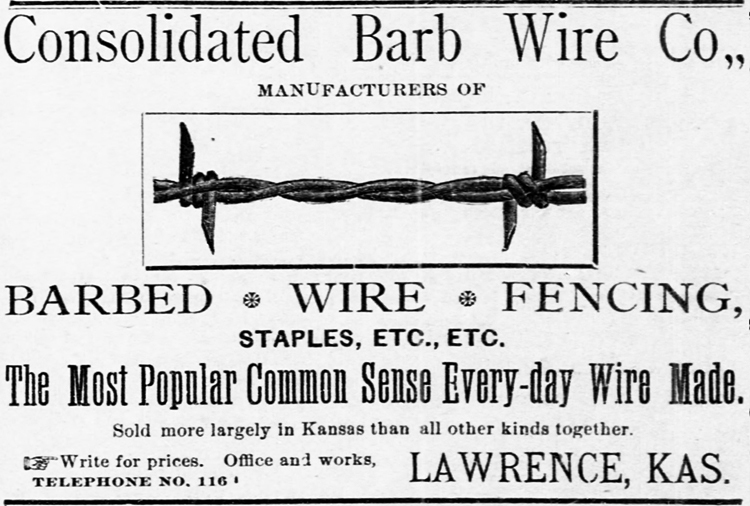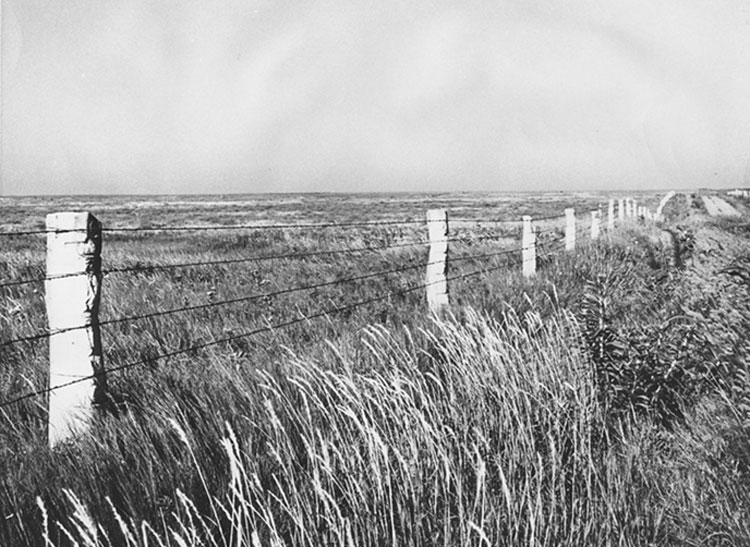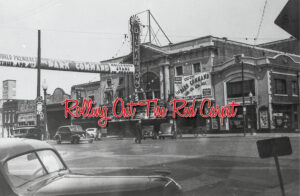Settling the Kansas Prairies—With Barbed Wire
During the settlement of the Midwest, local company eased pain of building fences on treeless prairies to keep livestock contained.
| 2017 Q2 | story by Patricia A. Michaelis, Ph.D., Historical Research & Archival Consulting
Photos from the Kansas State Historical Society, kansasmemory.org

Consolidated Barb Wire Co.
A Lawrence manufacturing company—Consolidated Barb Wire Co.—made an important contribution to the settlement of western Kansas and adjacent states. The treeless prairies made it difficult for farmers to build traditional wooden fences to keep in domestic cattle and to keep out buffalo and Texas longhorns being driven to railheads in Abilene and later Dodge City. The solution to this problem was the invention of barbed wire by Illinois farmer Joseph Glidden in 1873. This invention, and numerous patented versions of barbed wire, made it possible to build fences with minimal lumber (or limestone in some parts of western Kansas) for fenceposts with several strands of barbed wire. The barbs on the wire were sharp enough to “discourage” livestock from destroying the fences. Use of barbed wire also lowered the cost of fencing dramatically, and farmers and ranchers “fenced in” larger pastures or ranges. The wire was attached to the posts in various ways, but building sturdy corner posts and having enough tension on the wire to prevent sagging were keys to fence-building.
Albert Henley founded the Lawrence Barbed Wire manufactory, the predecessor to Consolidated Barb Wire. Henley was born in Indiana and moved to Iowa, where he manufactured barbed wire on a small scale. He and his wife moved to Lawrence in 1878, where he continued to manufacture barbed wire. By 1882, he owned nine machines that produced 10,000 pounds of barbed wire per day. In 1883, Henley and several other small barbed wire companies merged to become Consolidated Barb Wire. The building housing the factory was 60 x 100 feet and two stories high. The first floor opened on a level with the railroad tracks so the wire could be unloaded and loaded easily.
In 1891, a new building was constructed. It had a 300-foot frontage and extended back 60 feet. This building was next to the Santa Fe Railroad tracks between New Hampshire and Rhode Island streets. While one story at street level, the west half of the building had a basement that was created from the bluff on which the building sat. The building was a combination of wood and brick. The brick portion housed boilers and other machinery, and was designed to be fireproof. The factory would employ 40 men, “all or nearly all of whom are heads of families, thus it will be seen this institution provides a means of subsistence for nearly two hundred people, indirectly.” The 1891 building still stands (Abe and Jake’s is housed there now) and is listed on the National Register of Historic Places as part of East Lawrence Industrial Historic District.
Initially, Henley imported wire from the east, and the company turned it into barbed wire. By the mid- 1890s, he began purchasing the steel rods to manufacture barbed wire from start to finish in his own plant with a machine he invented himself. The process first involved making and then galvanizing the wire to prevent rusting. The steel rods were heated, and the wire was “drawn.” An article in the Lawrence Daily Journal Nov. 16, 1898 described the galvanizing process as follows:
- The galvanizing process is an interesting one and this new department at the mill will be the occasion of many inquiries about the operation. After the wire is drawn to its proper size it is sent on to the galvanizing room without going through the annealing process. It is at once started through the furnace in this department and then on through the other processes that complete the operation. A furnace forty-eight feet long is the first thing the wire is introduced to. The furnace is built with an arched roof of special bricks, through which there are holes that the strands of wire may be drawn. These flues run the entire length of the furnace. The brick are kept at a white hot heat all the time, the furnace so arranged that the fire is drawn along underneath the arched brick, and then back over the top. As the wire comes out of the furnace it is red hot. After running twenty to thirty feet through the air it is doused through a water tank then a cold muriatic acid bath is given to the wire followed by another muriatic acid bath heated by steam. The wire then goes into a vat of spelter or zinc, and is there coated and becomes galvanized. As it comes out of this bath it is run through an asbestos wiper that removes extra zinc. The wire is cooled and cleaned by running through a final water bath and then goes to the machine where it is wound on spools.
The automatic wire machine took wire from three coils, twisted two of the strands together and attached barbs cut from the third to the twisted pair. The zinc from the galvanizing process came from mines in southeast Kansas, and Consolidated used 10,000 tons of zinc every 20 days.

Barbed wire on the prairie.
Henley’s business expanded beyond barbed wire to woven fencing, bail ties and nails, with barrels for the nails made locally by two companies: Railbe Brothers and Hauber Brothers. In the early 1890s, the “wire mill,” as it was known to Lawrence residents, employed approximately 150 people. However, difficulties were on the horizon. Large numbers of lawsuits over patents for wire had been disputed in the courts for years. In addition, American Steel and Wire Co. made several attempts to buy Henley’s plant, but he refused their offers. In the end, American Steel and Wire secured a monopoly and the steel rods used to make the wire. Apparently, the company threatened that it would not sell Henley the raw materials needed to make the barbed wire. Faced with this ultimatum, Henley sold Consolidated Barb Wire to American Steel and Wire in 1899.
Henley’s new business, the American Cement Plaster Co., produced cement plaster that was a mixture of suitable plaster, sand, Portland cement and water that is normally applied to masonry interiors and exteriors to achieve a smooth surface. He and his new company continued to have an impact on Lawrence’s economy. He also was involved in local politics, being elected mayor in 1888. He served as a state representative for two terms and as a state senator. Henley died in 1919, but Consolidated Barb Wire was the first factory in Kansas to manufacture this specialized wire. Because the business dominated the Kansas market, it can be credited for its impact on helping settlers operate farms and ranches in the prairies of western Kansas.




54 Comments
saДџlam bahis siteleri 2025 en iyi casino sitesi eski oyunlarД± oynama sitesi
en iyi yabancД± bahis siteleri: bet turkiye – deneme bonusu veren yeni siteler 2025
Também tenho o seu livro marcado para ver coisas novas no seu blog.
http://casinositeleri2025.pro/# vidobet giriЕџ 2025
pinup2025.com пин ап казино зеркало пин ап казино официальный сайт
https://casinositeleri2025.pro/# siteler bahis
en kazancl? slot oyunlar?: slot siteleri – en kazancl? slot oyunlar?
I will revisit once again since i have book-marked it. Money and freedom is the best way to change, may you be rich and continue to guide others.
mexico drug stores pharmacies Mexican pharmacy ship to usa mexican drugstore online
medicine in mexico pharmacies: mexicanpharmi – buying prescription drugs in mexico
https://canadianpharmi.com/# viagra without a doctor prescription walmart
mexican border pharmacies shipping to usa Mexican pharmacy ship to usa buying from online mexican pharmacy
cheap erectile dysfunction pills online: Cheapest drug prices Canada – pet antibiotics without vet prescription
http://canadianpharmi.com/# sildenafil without a doctor’s prescription
buying prescription drugs in mexico mexicanpharmi mexican online pharmacies prescription drugs
best over the counter ed pills: canadian pharmacy – erectile dysfunction treatment
http://canadianpharmi.com/# erectile dysfunction drug
buying prescription drugs in mexico mexicanpharmi mexican online pharmacies prescription drugs
male erection: Cheapest drug prices Canada – erection pills online
medicine in mexico pharmacies: Mexican pharmacies that ship to the United States – mexican pharmaceuticals online
http://indiapharmi.com/# Online medicine order
п»їbest mexican online pharmacies: Legit online Mexican pharmacy – mexican mail order pharmacies
buy prescription drugs canadian pharmi non prescription erection pills
http://mexicanpharmi.com/# п»їbest mexican online pharmacies
prednisone 10 mg canada prednisone 475 prednisone 40 mg daily
ciprofloxacin over the counter: cipro 500mg best prices – cipro online no prescription in the usa
http://prednibest.com/# where to buy prednisone 20mg
can you get cheap clomid no prescription clomid on pharm cost cheap clomid pills
http://amoxstar.com/# generic amoxicillin over the counter
cipro online no prescription in the usa buy generic ciprofloxacin where can i buy cipro online
http://prednibest.com/# prednisone 20 mg tablets coupon
cipro online no prescription in the usa antibiotics cipro buy cipro online
prednisone 50 mg prices: Predni Best – prednisone 100 mg
https://prednibest.com/# 20 mg prednisone
how to buy prednisone buy prednisone 1 mg mexico no prescription prednisone canadian pharmacy
amoxicillin where to get: amoxicillin 500mg capsules uk – amoxicillin discount
https://clomidonpharm.com/# can you buy clomid without insurance
buy cipro online usa CiPharmDelivery cipro pharmacy
where to buy cheap clomid no prescription: clomid on pharm – can i purchase clomid without rx
https://amoxstar.com/# rexall pharmacy amoxicillin 500mg
information.|My family members every time say that I am killing my time here
prednisone 1 mg daily PredniBest best pharmacy prednisone
http://prednibest.com/# buy prednisone tablets uk
cipro ciprofloxacin: CiPharmDelivery – buy cipro online without prescription
buy amoxicillin without prescription amoxicillin online without prescription amoxicillin no prescipion
http://prednibest.com/# where can i buy prednisone
amoxicillin discount coupon: Amox Star – amoxil generic
prednisone 20 mg purchase PredniBest prednisone 200 mg tablets
https://prednibest.com/# cost of prednisone 10mg tablets
how to get cheap clomid: can i buy clomid without a prescription – can i purchase generic clomid pill
prednisone 20 mg generic Predni Best average cost of prednisone 20 mg
prednisone 50 mg buy: Predni Best – fast shipping prednisone
http://prednibest.com/# prednisone 10 mg coupon
cipro pharmacy: CiPharmDelivery – buy cipro online